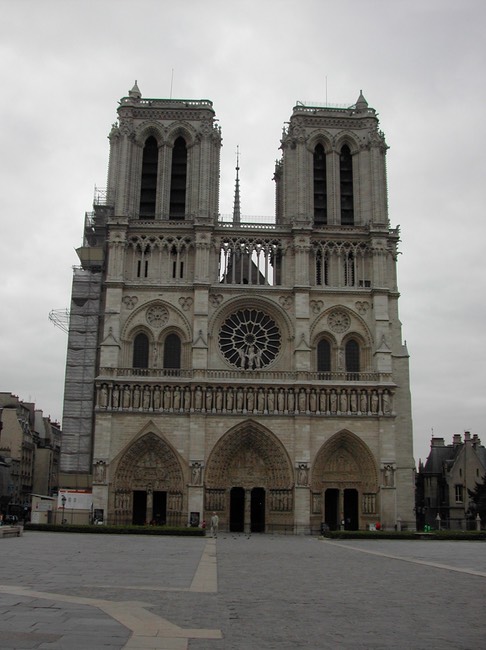La Belle France
Oasis in Central Paris
Our week in Paris was spent in a neighbourhood remarkable for its lack of tourists, yet only steps away from some of the most visited sites in the city. The famous Latin Quarter of the fifth arrondissement lies on the slopes of the hill capped by the domed Pantheon, and includes the busy rue Saint-Germain, lined with well-populated cafés and restaurants. At the bottom of the hill are the bridges of the Seine and the spires of Notre-Dame Cathedral. Within fifteen minutes walk are the Luxembourg Garden, the nightlife of the Boulevard Saint-Michel, and the famous cafés of the sixth arrondissement.

And yet, we returned each day from our travels around the city to a home-like oasis, bustling in a remarkably quotidien way. Our little apartment was in an ancient, well-fortified stone building on a quiet street halfway between Notre-Dame and the Pantheon. Around the corner was the busy rue Monge, a commercial artery that runs almost the length of the arrondissement. It was on this street that we began most days, at the amazing Maison Kayser, where we purchased delicious breakfasts of chewy baguettes and melt-in-your-mouth croissants.
At the end of our block, a tiny, unnamed square contained two cafes, an Irish pub, and a dimly-lit wine bar. The small, triangular place was surrounded by buildings five and six stories high, lined with tall windows and iron railings. At one corner was a small fountain, always surrounded by motorcycles, and the rest of the triangle was filled with small tables beneath awnings. It was here, after returning from our day’s activities, that we chose to take our ease with a pichet of house wine and an orangina for our son. Typically, the tables were arranged in close rows, with little space between us and the other patrons. We sat looking outward, listening to the buskers singing and playing their guitars a few feet away, talking, playing cards, sipping cool drinks. (My French is not adequate to Parisian arguments, but I would swear that the two men seated next to us upon one occasion were debating the subject of cooking!)
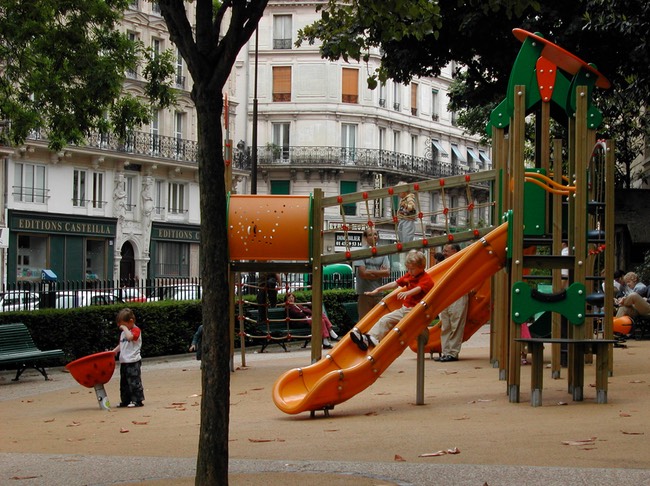
Afterward, we would seek out the places where the local families took their children to play before dinner. Nearby, a small playground at the corner of two busy streets was always crowded after four-thirty, and our son joined the Parisian children in their play. Or we might take a stroll through the Jardin des Plantes, the large park on the eastern edge of the Fifth which was far less crowded than its more famed cousin, the Luxembourg. It features botanical gardens and greenhouses, the Museum of Natural History, and a small zoo. The garden strolls are free, and there are play structures and a carousel.
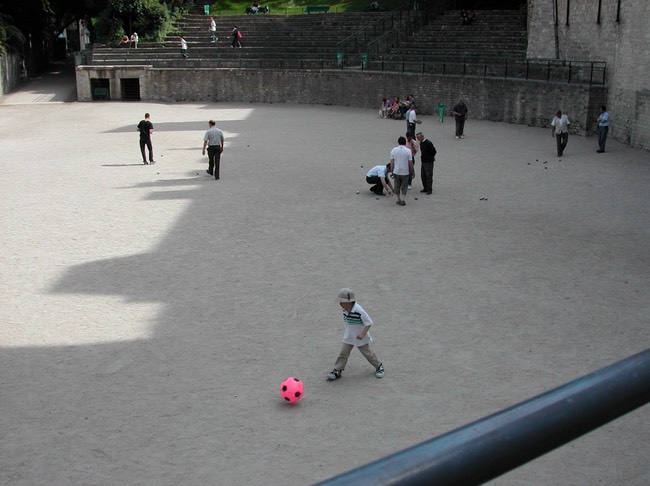
Some days we took a soccer ball to the Arènes de Lutèce, a hidden gem adjacent to the rue Monge. When we first walked through the portal of the sunken amphitheatre, late in the afternoon of a warm day, we found a group of young adults playing soccer in one corner, some younger children kicking a ball in another, and a group of men playing the quintessential game of boules. Above the amphitheatre, children ran and played among the trees. It was never crowded, and in all the time we spent there over several days, we saw one pair of tourists walk through. To me, it felt as if we had discovered, not an architectural treasure, but a secluded neighbourhood park, where the locals went with their children in the cool of the evening, and the boules players met for their daily tournament.
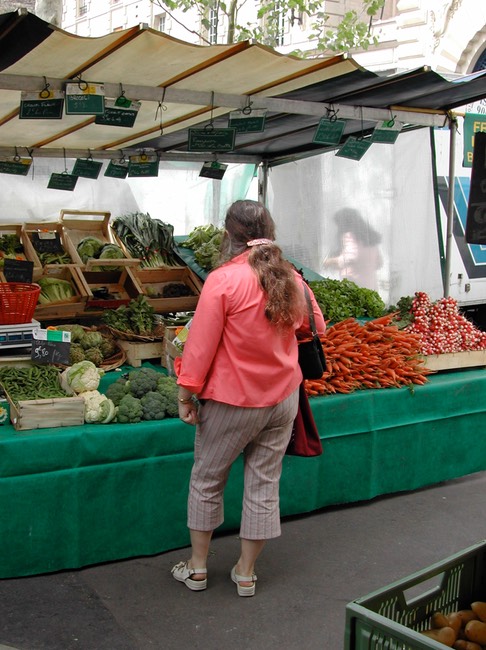
There were two markets within walking distance of our apartment, on alternating days. Three days a week, we could walk down the hill a few short blocks to the Place Maubert, where the featured fresh spring produce: fava beans, broccoli, strawberries, potatoes, and giant bunches of dark green spinach. Across the street was a wine shop, and a cremerie where we purchased cheese, butter, and cream. On alternate days, we traveled a little further, to the market at Place Monge, where we bought fresh fruit and greens, farm-fresh goat cheese, olives and nuts, and large purple bulbs of fragrant garlic. The Saturday market was the liveliest of all, when additional tables were jammed into the Place Maubert, filled with kitchen linens, housewares, and clothes. One booth sold scarves in multiple colours, folded into squares and lining the table, and hanging in great swathes from the awning.
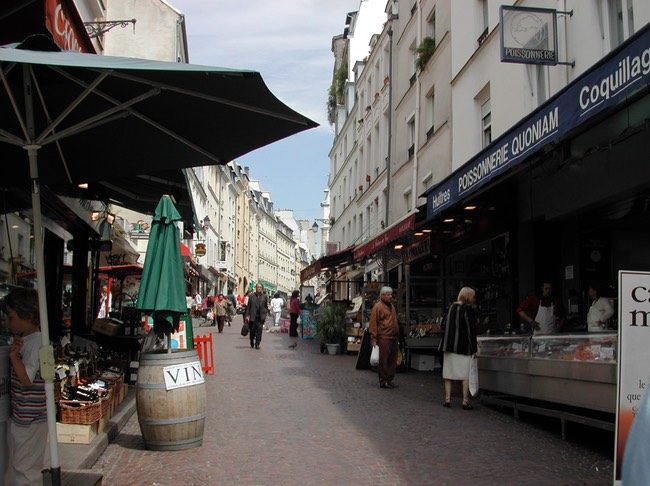
One of our favourite walks both in the daytime and evening was the charming rue Mouffetard, a narrow pedestrian street that winds its way down the other side of the hill, lined with a mixture of shops, restaurants, and food stores. Wine shops, fromageries, boulangeries, and shops selling crepes and grilled panini: we visited them all, delighting in the wonderful treats we could buy. The restaurants included Greek and Italian food, crêpes and panini, Alpine-style raclette, and traditional bistro fare.
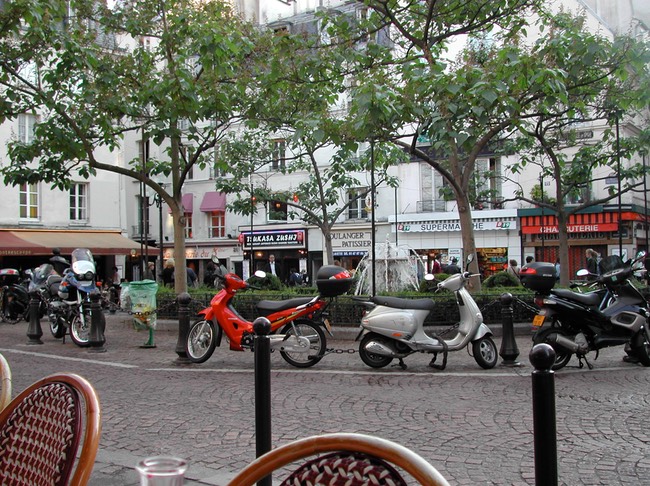
Halfway down the hill is the Place de la Contrescarpe, a delightful square surrounded by cafes and restaurants, and at its centre a fountain lined with the ubiquitous motorcycles. This square was lively whenever we passed through it, early in the day when people enjoyed their café and brioche, in the afternoon when patrons had sandwiches and beer or wine, and late into the evening when the fountain was lit and people came and went.
In our neighbourhood, in the very historic heart of left bank Paris, we never felt overwhelmed by the presence of other tourists, or that we were moving among crowds of foreigners. On the contrary, we felt a hint of the life that a native Parisian might experience, the day to day possibilities of the City of Light.
Photos: Looking down rue des Carmes toward Notre Dame, La Petite Café, playground on rue Monge, Arène de Lutèce, market at Place Monge, rue Mouffetard, Place de la Contrescarpe
Early Morning at Notre-Dame
Outside my doorstep runs a short street, one block long, lined with apartments and small businesses. The businesses are not the kind that will bring heavy traffic to the area– a tailor, a tiny academic bookshop, a Middle Eastern sandwich shop. The apartments are entered by massive doors of dark wood, presumably as well-secured as mine. A few steps takes me to the corner of the rue des Carmes, which runs downhill between the Pantheon and the Seine. The domed edifice looms above me at the top of the hill; in the other direction, the towers of Notre-Dame can be seen.
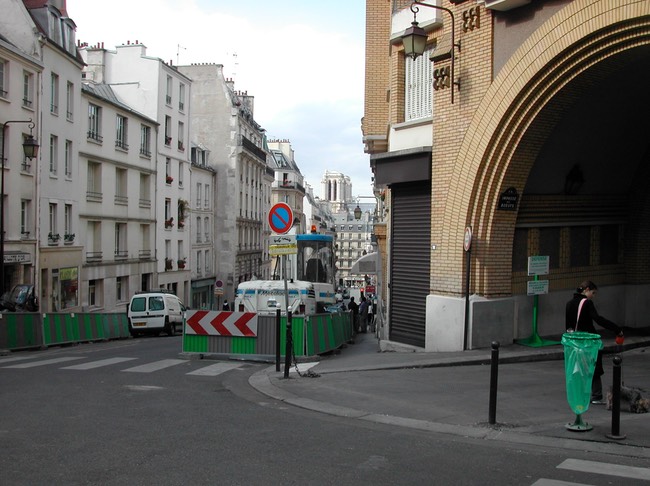
It is early. People are passing quickly along the narrow streets, on their way to work. Halfway down the hill at Place Maubert, commuters come and go from the Metro entrance, while merchants busily set up their stalls at the small market. It is not the larger, more colourful Saturday version, but the more down-to-earth market of mid-week, providing the daily necessities of fruit, nuts, vegetables, and fish for the residents of the area. The boulangerie facing the square is doing a brisk business.
I walk through the still-quiet streets down toward the river, crossing the noisy rue Saint-Germain, with its lanes of traffic and large cafes and restaurants. Between here and the river, the outdoor tables are just beginning to fill up with breakfasting tourists. As I walk onto one of the many bridges that crisscross the river, I feel the morning sun on my face.
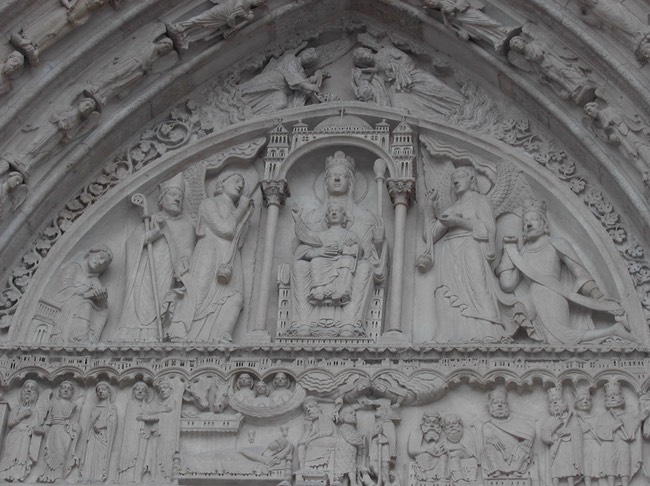
Across the river, the large square in front of Notre-Dame is largely empty at this hour. The sun shines behind the massive cathedral, casting shadows upon the ground. Later in the afternoon, when the sun is in the west, it will light up the creamy stone of the façade, highlighting the arches of intricate sculptures that surround the huge doors. There, amid the saints, angels, and Biblical kings that preside over this immense house of God, my eyes seek out the figures of people long dead; men whose faces and names were well-known to the Parisians of eight hundred years ago, but whose fame is now limited to those like myself, students of this place in that time: King Louis VII, the pious twelfth-century king whose patronage helped make the cathedral a reality, and Bishop Maurice de Sully, the holy and humane man whose vision it was. Although neither man lived to see the façade raised, their figures have presided down through the centuries over one of the great portals. I gaze up at their reproductions now in some undefined hope of communion with their long-vanished spirits.
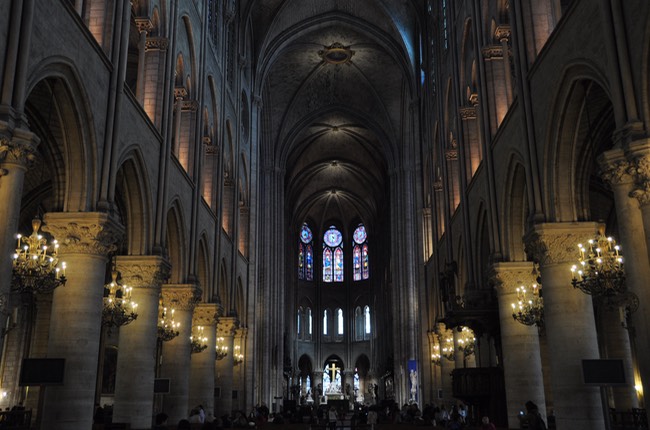
In a short time, this square will begin to fill, and will be busy throughout the day. Now, only the devout enter those great portals, and a few early risers who yearn to experience the cathedral without the crowds. Inside, it is very peaceful, only quiet footsteps and a few hushed voices breaking the profound, dimly-lit silence. As I look down the length of the nave, the massive columns that rise up along its length act as a wall, through which occasional glimpses of the side chapels can be seen. The nave appears narrow and very high, and there is not the blaze of colour and light that characterizes some of the smaller churches of its era. The encircling windows, high above the floor of the immense place, are rich in the deep, ancient colours of the thirteenth-century glassmakers, but they admit little light into the long, high space. At the end of the nave, however, the choir with its magnificent great altar gleams with the colour of its surrounding circle of windows. There is symbolism in this; perhaps deliberate, perhaps a happy accident of the challenges of designing a structure which was the largest of its day.
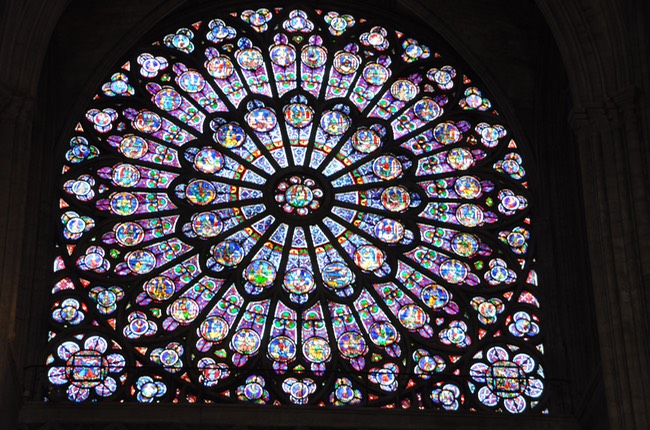
I walk along the side of the nave, stopping occasionally to touch one of the great multiple columns. As I move forward, I catch glimpses of the clearstory windows, where they seem to hover far above the lowly space in which I walk. Reaching the transept, I move out to the centre and, turning slowly, absorb the glory of the choir in front of me, and the great rose windows to either side of me at opposite ends of the transept. The western window, high above the white gleam of the arched portals, is partly obscured by the more modern addition of pipes; in the thirteenth century, the word “organist” referred to a singer of polyphony, and voices were the only music heard here.
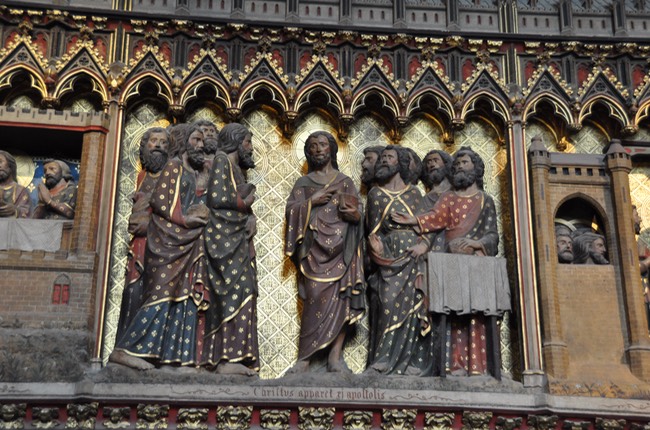
In my mind, I can hear this music, as I have sung it and heard it sung on recordings. It is rich, thrilling, glorious, from a time of one of the first great flowerings of religious music. One of the texts so set was the one that ran: “Locus iste a Deo factus est, inaestimabile sacramentum, irreprehensibilis est.” This place was made by God, a sacrament without price, and is without flaw. It is easy to imagine the glorious, free-flowing setting of these words being sung in this amazing place, where the presence of God and his long-dead servants feels so near.
I leave the cathedral as the Mass is about to begin. When it is over, I know, the tour buses will begin to arrive across the bridges, from north and south, and this place will become a tourist attraction, a piece of history certainly, but with something of its amazing holiness lost. In this early part of the day, it is still possible to touch, briefly, the souls of those who laboured here and worshipped here, from lofty kings and bishops to lowly artisans and labourers; they whose place this was, in the beginning.
Photos: Notre-Dame de Paris; view of the towers from the Left Bank; scuptures on the façade; the gothic nave; the north rose window; freize on the choir enclosure
